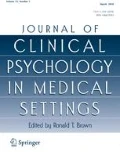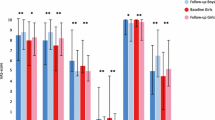Abstract
Patterns of agreement between parent and child ratings of psychosocial functioning and fatigue in children with obesity were examined. Analyses demonstrated moderate agreement for social anxiety in elementary children and small agreement for social anxiety in adolescents. Results of analyses of overall quality of life revealed small agreement in children under the age of 8, large agreement in children ages 8–12, and moderate agreement in adolescents ages 13–18. Overall ratings of fatigue demonstrated moderate agreement both in elementary children and in adolescents. A meaningful relationship was found between each factor measured by a parent and a child. Patterns which were unexpected given the existing literature were found; possible hypotheses explaining these patterns are presented; and the need for further research is highlighted.
Similar content being viewed by others
References
Buddeberg-Fischer, B., Bernet, R., Sieber, M., Schmid, J., & Buddeberg, C. (1996). Epidemiology of eating behaviour and weight distribution in 14- to 19-year-old Swiss students. Acta Psychiatica Scandinavica, 93, 296–304.
Calderon, C., Forns, M., & Varea, V. (2009). Adolescent obesity: Anxiety, cognitive, and behavioral symptoms characteristic of eating disorders. Anales de Pediatria (Barcelona), 71, 489–494. doi:10.1016/j.anpedi.2009.07.030.
Cohen, J. (1988). Statistical power analysis for the behavioral sciences (2nd ed.). New Jersey: Lawrence Erlbaum.
Cremeens, J., Eiser, C., & Blades, M. (2006). Factors influencing agreement between child self-report and parent proxy-reports on the Pediatric Quality of Life Inventory 4.0 generic core scales. Health and Quality of Life Outcomes, 4, 58. doi:10.1186/1477-7525-4-58.
Eiser, C., & Morse, R. (2001). Can parents rate their child’s health-related quality of life? Results of a systematic review. Quality of Life Research, 10, 347–3577. doi:10.1023/A:1012253723272.
Falkner, N. H., Neumark-Sztainer, D., Story, M., Jeffery, R. W., Beuhring, T., & Resnnick, M. D. (2001). Social, educational, and psychological correlates of weigh status in adolescents. Obesity Research, 9, 32–42.
Feichtl, R. E., Rosenfeld, B., Tallamy, B., Cairo, M. S., & Sands, S. A. (2010). Concordance of quality of life assessments following pediatric hematopoietic stem cell transplantation. Psycho-Oncology, 19(7), 710–717. doi:10.1002/pon.1630.
French, S. A., Story, M., & Perry, C. L. (1995). Self-esteem and obesity in children and adolescents: a literature review. Obesity Research, 3, 479–490.
Giel, K. E., Zipfel, S., Schweizer, R., Braun, R., Ranke, M. B., Binder, G., … DISKUS Study Group. (2013). Eating disorder pathology in adolescents participating in a lifestyle intervention for obesity: Associations with weight change, general psychopathology and health-related quality of life. Obesity Facts, 6, 307–316. doi:10.1159/000354534.
Gilbert, V., Zipper, E., Dabbas, M., Bertrand, C., Robert, J. J., Ricour, C., & Mouren-Simeoni, M. C. (2004). Mental disorders in obese children and adolescents. Psychosomatic Medicine, 66, 387–394.
Hopkins, W. G. (2002). A new view of statistics: Effect statistics. Retrieved August 6, 2006 from http://www.sportsci.org/resource/stats/effectmag.html.
Kamphaus, R. W., & Frick, P. J. (1996). Clinical assessment of child and adolescent personality and behavior. Needham Heights, MA US: Allyn & Bacon.
La Greca, A. M. (1998). Manual for the Social Anxiety Scales for Children and Adolescents. Miami, FL: Author. Manual revised and reprinted in September 1999.
La Greca, A. M. (1999). The social anxiety scales for children and adolescents. The Behavior Therapist, 22(7), 133–136.
Langeveld, J. H., Koot, H. M., & Passchier, J. (1997). Headache intensity and quality of life in adolescents: How are changes in headache intensity in adolescents related to changes in experienced quality of life? Headache, 37, 37–42. doi:10.1046/j.1526-4610.1997.3701037.
Lanza, H. I., Echols, L., & Graham, S. (2013). Deviating from the norm: Body mass index (BMI) differences and psychosocial adjustment among early adolescent girls. Journal of Pediatric Psychology, 38, 376–386. doi:10.1093/jpepsy/jss130.
Majnemer, A., Shevell, M., Law, M., Poulin, C., & Rosenbaum, P. (2008). Reliability in the ratings of quality of life between parents and their children of school age with cerebral palsy. Quality of Life Research, 17, 1163–1171.
Manson, J. E., Skerrett, P. J., Greenland, P., & VanItallie, T. B. (2004). The escalating pandemics of obesity and sedentary lifestyle. A call to action for clinicians. Archives of Internal Medicine, 163, 249–253.
Martin, J. L., Ford, C. B., Dyer-Friedman, J., Tang, J., & Huffman, L. C. (2004). Patterns of agreement between parent and child ratings of emotional and behavioral problems in an outpatient clinical setting: When children endorse more problems. Developmental and Behavioral Pediatrics, 25, 150–155.
Morrow, A. M., Hayden, A., Quine, S., Scheinberg, A., & Craig, J. C. (2012). A comparison of doctors’, parents’, and children’s reports of health states and health-related quality of life in children with chronic conditions. Child: Care Health, and Development, 38, 186–195. doi:10.11111/j.1365-2214.2011.01240.x.
Must, A., Spadano, J., Coakley, E. H., Field, A. E., Colditz, G., & Dietz, W. H. (1999). The disease burden associated with overweight and obesity. Journal of the American Medical Association, 282, 1523–1529.
Pesa, J. A., Syre, T. R., & Jones, E. (2000). Psychosocial differences associated with body weight among female adolescents: The importance of body image. Journal of Adolescent Health, 26, 330–337.
Phillips, B. A., Gaudette, S., McCracken, A., Razzaq, S., Sutton, K., Speed, L., … Ward, W. (2012). Psychosocial functioning in children and adolescents with extreme obesity. Journal of Clinical Psychology in Medical Settings, 19(3), 277–284.
Rapee, R. M., Barrett, P. M., Dadds, M. R., & Evans, L. (1994). Reliability of the DSMIII-R Childhood anxiety disorders using structured interview: Interrater and parent–child agreement. Journal of the American Academy of Child and Adolescent Psychiatry, 33, 984–992.
Sallinen, B. J., Hassan, F., Olszewski, A., Maupin, A., Hoban, T. F., Chervin, R. D., & Woolford, S. J. (2013). Longer weekly sleep duration predicts greater 3-month BMI reduction among obese a clinical multidisciplinary weight management program. Obesity Facts, 6, 239–246.
Schwimmer, J. B., Burwinkle, T. M., & Varni, J. W. (2003). Health-related quality of life of severely obese children and adolescents. Journal of the American Medical Association, 289, 1813–1819.
Selewski, D. T., Collier, D. N., MacHardy, J., Gross, H. E., Pickens, E. M., Cooper, A. W., … Gipson, D. S. (2013). Promising insights into the health related quality of life for children with severe obesity. Health Qual Life Outcomes, 11, 29.
Shrout, P. E., & Fleiss, J. L. (1979). Intraclass correlation: Uses in assessing reliability. Psychological Bulletin, 86, 420–428.
Su, C., Wang, J., & Lin, C. (2013). Child-rated versus parent-rated quality of life of community-based obese children across gender and grade. Health and Quality of Life Outcomes, 11, 206–212.
Thompson, J., Phillips, B. A., McCracken, A., Thomas, K., & Ward-Begnoche, W. L. (2013). Social anxiety in obese youth in treatment setting. Child and Adolescent Social Work, 30(1), 37–47.
Thompson, J., Phillips, A. B., McCracken, A., Thomas, K., & Ward-Begnoche, W. L. (2016). Social anxiety in obese children and adolescents. Journal of Child & Family Studies.
Upton, P., Lawford, J., & Eiser, C. (2008). Parent-child agreement across child health-related quality of life instruments: A review of the literature. Quality of Life Research, 17, 895–913.
Varni, J. W., Burwinkle, T. M., & Szer, I. S. (2004). The peds QL Multidimensional Fatigue Scale in pediatric rheumatology: Reliability and validity. Journal of Rheumatology, 31, 2494–2500.
Varni, J. W., Katz, E. R., Seid, M., Quiggins, D. J., Friedman-Bender, A., & Castro, C. M. (1998). The pediatric cancer quality of life inventory. I. Instrument development, descriptive statistics, and cross-informant variance. Journal of Behavioral Medicine, 21, 179–204.
Varni, J. W., Seid, M., Knight, T. S., Burwinkle, T., Brown, J., & Szer, I. S. (2002a). The Peds QL in pediatric rheumatology: reliability, validity, and responsiveness of the pediatric quality of life inventory generic core scales and rheumatology module. Arthritis Rheumatology, 46, 714–725.
Varni, J. W., Seid, M., Knight, T. S., Uzark, K., & Szer, I. S. (2002b). The Peds QL 4.0 generic core scales: sensitivity, responsiveness and impact on clinical decision-making. Journal of Behavioral Medicine, 25, 175–193.
Varni, J. W., Seid, M., & Kurtin, P. S. (2001). The Peds QL 4.0: Reliability and validity of the Pediatric Quality of Life Inventory Version 4.0 generic score scales in healthy and patient populations. Medical Care, 39, 800–812.
Varni, J. W., Seid, M., & Rode, C. A. (1999). The Peds QL: Measurement model for the Pediatric Quality of Life Inventory. Medical Care, 37, 126–139.
Author information
Authors and Affiliations
Corresponding author
Ethics declarations
Conflict of Interest
Jennifer Harman Ehrentraut, Eileen Chaves, Xingu Tang, Julia Thompson and Wendy L. Ward declare they have no conflict of interest.
Human Rights and Informed Consent
All procedures followed were in accordance with the ethical standards of the responsible committees on human experimentation and with the Helsinki Declaration of 1975, as revised in 2000. Informed consent was obtained from and for all participants for being included in this study.
Rights and permissions
About this article
Cite this article
Ehrentraut, J.H., Chaves, E., Tang, X. et al. Do Parents and Overweight, Treatment-Seeking Youth Provide Similar Ratings of Youths’ Psychosocial Functioning and Fatigue?. J Clin Psychol Med Settings 23, 247–256 (2016). https://doi.org/10.1007/s10880-016-9458-7
Published:
Issue Date:
DOI: https://doi.org/10.1007/s10880-016-9458-7



